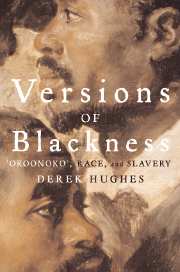Book contents
- Frontmatter
- Contents
- Introduction
- A Note on the Texts
- Chronology
- PART ONE THE MAJOR TEXTS
- PART TWO CONTEXTS: EUROPE, AMERICA, AND AFRICA
- A Short Account of the Destruction of the Indies
- Democrates Secundus
- “Of the Cannibals” and “Of Coaches”
- On Spreading the Gospel Among the Savages
- The English-American his Travail by Sea and Land
- A True and Exact History of the Island of Barbados
- The History of Sir Francis Drake
- Voyage de la France Equinoxiale en l'Isle de Cayenne
- An Exact Relation of the Most Execrable Attempts of John Allin
- The History of the Caribby-Islands
- Histoire Generale des Antilles Habitées par les François
- An Impartial Description of Surinam
- Great Newes from the Barbadoes
- The Negro's and Indians Advocate
- Friendly Advice to the Gentlemen Planters of the East and West Indies
- DISCUSSIONS OF COLONIALISM
- Bibliography
- Index
An Exact Relation of the Most Execrable Attempts of John Allin
Published online by Cambridge University Press: 05 June 2012
- Frontmatter
- Contents
- Introduction
- A Note on the Texts
- Chronology
- PART ONE THE MAJOR TEXTS
- PART TWO CONTEXTS: EUROPE, AMERICA, AND AFRICA
- A Short Account of the Destruction of the Indies
- Democrates Secundus
- “Of the Cannibals” and “Of Coaches”
- On Spreading the Gospel Among the Savages
- The English-American his Travail by Sea and Land
- A True and Exact History of the Island of Barbados
- The History of Sir Francis Drake
- Voyage de la France Equinoxiale en l'Isle de Cayenne
- An Exact Relation of the Most Execrable Attempts of John Allin
- The History of the Caribby-Islands
- Histoire Generale des Antilles Habitées par les François
- An Impartial Description of Surinam
- Great Newes from the Barbadoes
- The Negro's and Indians Advocate
- Friendly Advice to the Gentlemen Planters of the East and West Indies
- DISCUSSIONS OF COLONIALISM
- Bibliography
- Index
Summary
Surinam was faction-ridden, though it is difficult from the surviving records to reconstruct the nature of the power struggles. In 1663, the Baptist Henry Adis wrote to Lord Willoughby, complaining of “drunkenness and so much debauchery” in the “rude rabble,” and of “many bitter Oaths, horrid Execrations, and lascivious Abominations.” Byam appears as an honorable and trustworthy figure in the accounts of Biet and Warren, and as the voice of Christian morality in the following document. Yet he was the villain of the piece in an account by Lt. Col. Robert Sanford, a member of the colony's council, who accused Byam of bypassing democratic process in the aftermath of the Restoration and seeking absolute authority. Each side accused the other of drunkenness. It is clear that there was considerable unrest, and Sanford prides himself on not misusing a force that he was to lead against the Indians. Confusingly, George Marten – Byam's exemplary antagonist in Oroonoko – is in Sanford's account his unscrupulous accomplice, of “violent counsels,” and “offering himself the Hangman of any at the Governours single command.” The present document, written by William Byam, documents an assault on Lord Willoughby.
There are some details in Byam's account of Allin's crime that may have impressed Behn: the protagonist's self-destructiveness, his taste for romance and biographies of the Romans, and the treatment of his body.
- Type
- Chapter
- Information
- Versions of BlacknessKey Texts on Slavery from the Seventeenth Century, pp. 315 - 321Publisher: Cambridge University PressPrint publication year: 2007



